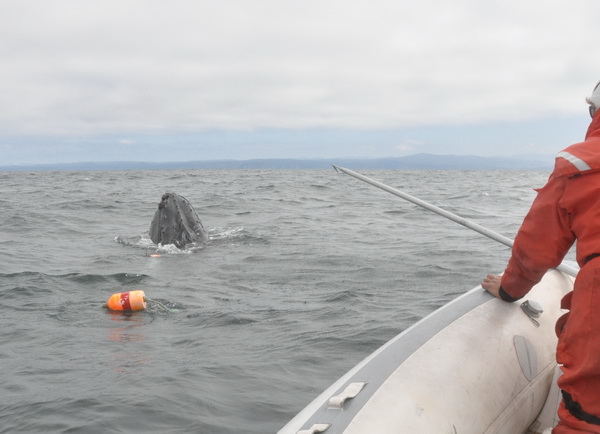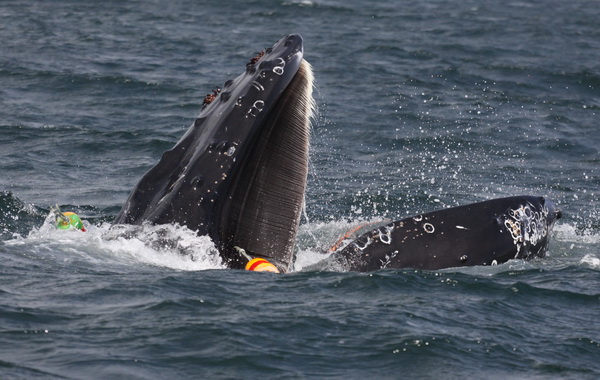Efforts to free entangled humpback whale of Washington
Update through 14 May 2010
Surveys conducted on 14 May 2010 by Cascadia Research, Makah Fisheries, and the US Coast Guard in cooperation with NOAA Fisheries did not locate the entangled whale or detect a signal from the VHF radio transmitter that had been attached to one of the buoys when disentanglement efforts were suspended on 13 May. The primary disentanglement team from Cascadia suspended operations mid-afternoon today pending additional sighting reports of the whale.
The search on the 14th followed a hectic but productive effort on 13 May that resulted in a number of lines being cut free of the head, back, and tail of the whale. The whale remained attached to floats and multiple crab pots from its pectoral (side) fin which extended down below the whale and largely out of reach with the tools available. Operations were suspended on the 13th as wind and seas became rougher and the team realized they needed some additional tools to access and cut the lines that were deep under the whale. They had also sustained self-inflicted damage to their boat during the effort (a puncture of one of the pontoons) that was repaired late on the 13th. On the evening of the 13th, a fisherman working in the same area reported seeing the whale about a mile from where it had been and apparently headed west offshore.
The apparent movement of the whale based on the sighting late on the 13th and it not being found on the 14th could mean the whale is more mobile than it had been possibly as a result of some of the lines that had been removed. The failure to detect the VHF signal on the 14th could mean the whale has left the area (the transmitter typically has a range of about 10 miles) or could mean it is not transmitting because it is underwater, has been knocked off the buoy, or has failed for other reasons.
Mariners are asked to report any sightings of a whale that has buoys or ropes attached (see photos below) to the Coast Guard and not try to approach the whale or cut away any of the buoys (which includes the tracking the buoy). The disentanglement team from Cascadia consisted of John Calambokidis, Annie Douglas, and Jeff Foster. Cascadia will be working with NOAA, the Coast Guard, and Makah Fisheries to monitor any resightings of this whale and evaluate additional efforts to disentangle the animal.
Photos by Cascadia Research, Olympia, WA.
For additional information or requests please email John Calambokidis at Calambokidis@CascadiaResearch.org


